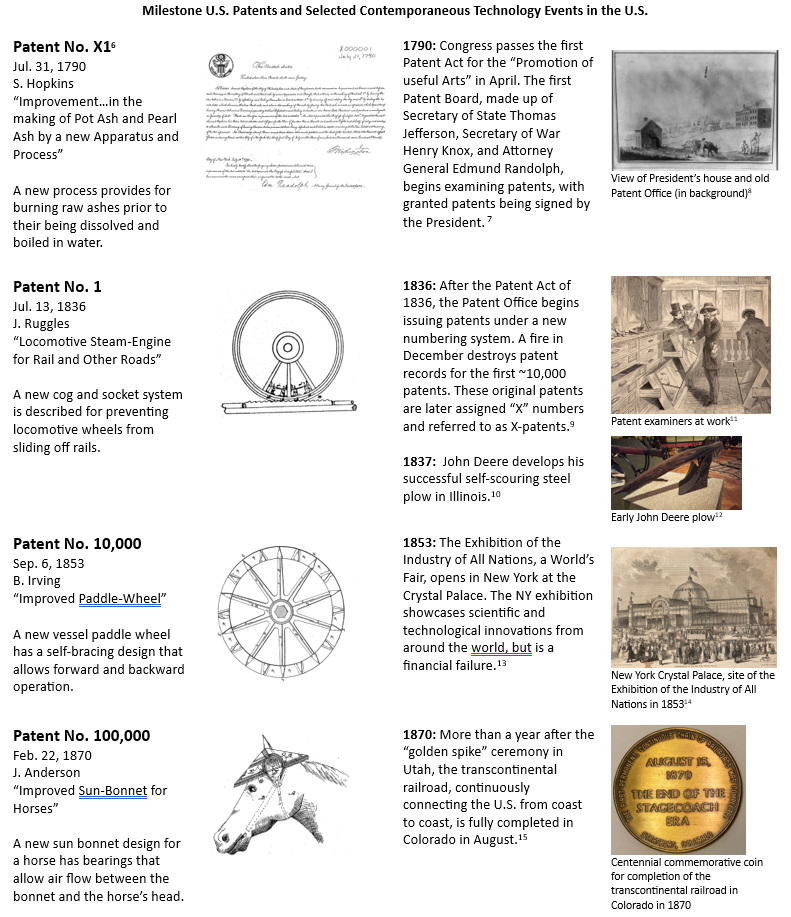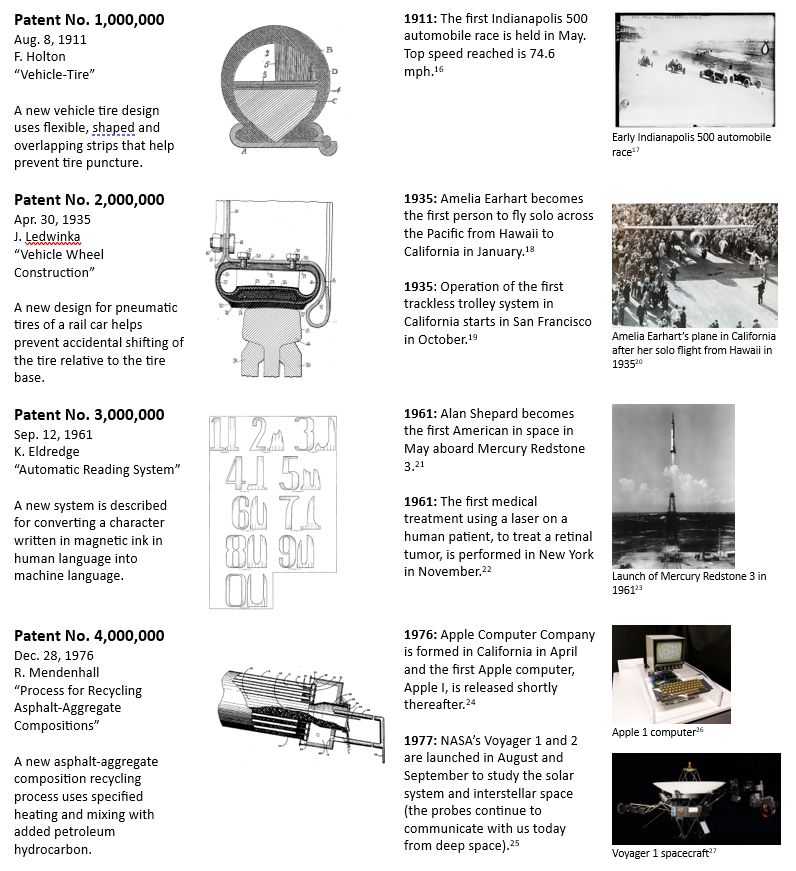
INNOVATE Magazine
INNOVATE is the online magazine by and for AIPLA members from IP law students all the way through retired practitioners. Designed as an online publication, INNOVATE features magazine-like articles on a wide variety of topics in IP law.
The views and opinions expressed in these articles are those of the authors and do not necessarily reflect the views or positions of AIPLA.
Articles
In This Section
The Progress of Technology, by the (Patent) Numbers
Elijah E. Cocks
“[The Congress shall have Power . . . ] To promote the Progress of Science and useful Arts, by securing for limited Times to Authors and Inventors the exclusive Right to their respective Writings and Discoveries.”
- U.S. Constitution, Article I, Section 8, Clause 8
Introduction
Innovation is embedded in the founding framework of the United States. From its ratification in 1788, the U.S. Constitution emphasized the effort “to promote the Progress of Science and useful Arts” that resulted in the formation of the U.S. Patent Office (and the U.S. Copyright Office). More than 230 years later, the U.S. Patent and Trademark Office (USPTO) has recently issued the 1 millionth design patent,[1] and the grant of U.S. utility Patent No. 12,000,000 is right around the corner, expected in Spring 2024.
But amidst the proliferation of U.S. patents, there is a question raised: Do patents, in fact, promote the progress of “useful Arts,” i.e., technology? Some argue that patents, as weapons to use against new entrants to a market, actually discourage innovation and that society would be more innovative without them. In rebuttal, others point to an inherent unfairness and obstacle to innovators and inventors if there is no system to allow for the protection of one’s intellectual property, and to the incentive to innovate that a patent system offers. [2] [3] The answer is perhaps unclear. In view of this debate, this article presents a chronology of certain issued U.S. patents in comparison to a timeline of the technology environment in which these U.S patents were granted.
Patents and Technology
Milestone patents, identified based on their numbers, are often heralded as representative of the “innovation and ingenuity” of the times. [4] [5] At the very least, these numerically-satisfying patents, marking the first, thousandths, millionths patent numbers, cannot help but be viewed as “mile markers” of the U.S. patent system. Whether or not representative of the salient technologies of their eras, let us consider some milestone U.S. patents in the context of the progressing technology environment in which they were granted, as represented by selected contemporaneous technology events. The milestone patents and comparative U.S. technology event timeline are presented in the table below.




Chronicling Progress
While the reach of technology is perhaps unbounded, our ability to progressively learn and innovate is contingent on sharing information about current technologies among the innovators. In the ancient world, Aristotle took on the task of attempting to record all knowledge of his time. Today, one might argue, patent offices have taken on a similar role, acting as repositories of information about the newest technological innovations for a broad range of subjects. With consistent formats in description, figures and claims, and having enough detail to enable “one of ordinary skill in the art” to make and use the claimed inventions, these structured documents, spanning centuries, are published in the patent databases. This permanent public disclosure is the price for temporary exclusive rights.[49]
Regardless of the debates around how effective for propelling innovation are the exclusive rights granted to patent holders, patent databases, maintained and made publicly accessible by patent offices, serve to record these incremental advances of society. Society’s collective knowledge benefits from this chronicle of technology’s progress.
[1] USPTO issues milestone 1 millionth design patent, USPTO Press Release, September 26, 2023: www.uspto.gov/about-us/news-updates/uspto-issues-milestone-1-millionth-design-patent.
[2] Tom Nicholas, Are Patents Creative or Destructive?, Antitrust Law Journal, 2014, Vol. 79, No. 2 (2014), pp 405-421, 407: www.jstor.org/stable/43486910.
[3] The Great IP Debate: Do patents do more harm than good?, Science|Business, Viewpoint, 28 Jul 2016: sciencebusiness.net/news/79887/The-Great-IP-Debate%3A-Do-patents-do-more-harm-than-good%3F (last visited 22 Oct 2023).
[4] USPTO issues patent number 11,000,000, USPTO Press Release, May 11, 2021: www.uspto.gov/about-us/news-updates/uspto-issues-patent-number-11000000.
[5] Milestones in U.S. patenting, USPTO: www.uspto.gov/patents/milestones (last visited 22 Oct 2023).
[6] All U.S. issued patent information and images obtained from the USPTO: www.uspto.gov.
[7] Milestones, USPTO.
[8] Image from: www.loc.gov/resource/cph.3a48897. Library of Congress: No known restrictions on publication.
[9] Adam Bisno, The search for lost X-patents, Director’s Blog, USPTO, Jul 13, 2022: www.uspto.gov/subscription-center/2022/search-lost-x-patents.
[10] John Deere, John Deere & Company: www.deere.com/en/our-company/history/john-deere (last visited 22 Oct 2023).
[11] Image from: The Patent-Office, Harper’s Weekly, July 10, 1869. Author’s collection.
[12] Image from: commons.wikimedia.org/w/index.php?curid=55095805. By Rmhermen - Own work, CC BY-SA 4.0.
[13] Exhibition of the Industry of All Nations, Britannica: www.britannica.com/topic/Exhibition-of-the-Industry-of-All-Nations.
[14] Image from: Gleason’s Pictorial, Vol. 5, No. 4, Boston, July 23, 1853, p. 53. Author’s collection.
[15] Comanche Crossing, Colorado Encyclopedia: coloradoencyclopedia.org/article/comanche-crossing.
[16] The First Indianapolis 500, 1911, Henry Ford Museum of American Innovation: www.thehenryford.org/collections-and-research/digital-collections/expert-sets/105790 (last visited 22 Oct 2023).
[17] Image from: www.loc.gov/item/2014693034. Library of Congress: No known restrictions on publication.
[18] Amelia Earhart, Hawaii Aviation: aviation.hawaii.gov/aviation-pioneers/amelia-earhart (last visited 22 Oct 2023).
[19] Robert Callwell, Transit in San Francisco: A Selected Chronology, 1850–1995, San Francisco Municipal Railway, Sept 1999: archives.sfmta.com/cms/rhome/documents/TransitinSanFrancisco-CallwellChronologyweb.pdf.
[20] Image from: Amelia Earhart, My Flight from Hawaii, National Geographic Magazine, Vol. 67, No. 5, May 1935, pp. 593-609, 606. Photograph from George Palmer Putnam. Author’s collection.
[21] Mercury-Redstone 3: Freedom 7, NASA: www.nasa.gov/mission/mercury-redstone-3-freedom-7 (last visited 22 Oct 2023).
[22] It Happened Here: The Ruby Laser, Health Matters: Stories of Science, Care and Wellness, New York Presbyterian website: healthmatters.nyp.org/ruby-laser (last visited 22 Oct 2023).
[23] Image from: images.nasa.gov/details/jsc2007e046477. Courtesy NASA.
[24] Apple I Microcomputer, Smithsonian: americanhistory.si.edu/collections/search/object/nmah_1692121 (last visited 22 Oct 2023).
[25] NASA Voyager: voyager.jpl.nasa.gov/mission (last visited 22 Oct 2023).
[27] Image from: voyager.jpl.nasa.gov/galleries/images-of-voyager/#gallery-1. Courtesy NASA/JPL-Caltech.
[28] The Human Genome Project, National Human Genome Research Institute website: www.genome.gov/human-genome-project.
[29] A short history of the Web, CERN: home.cern/science/computing/birth-web/short-history-web (last visited 22 Oct 2023).
[30] Image from: www.genome.gov/image-gallery#nanogallery/nanogallery2/0/51187222421. Courtesy National Human Genome Research Institute.
[31] Napster, Britannica: www.britannica.com/topic/Napster (last visited 22 Oct 2023).
[32] Lifetime sales of video game consoles worldwide as of May 2023, Statista: www.statista.com/statistics/1101872/unit-sales-video-game-consoles (last visited 22 Oct 2023).
[33] Image from: commons.wikimedia.org/w/index.php?curid=12821919. By Evan-Amos - Own work, Public Domain.
[34] S.G. Gregory et al., The DNA sequence and biological annotation of human chromosome 1, Nature, 2006 May 18;441(7091):315-21. doi: 10.1038/nature04727.
[35]Apple Inc., Apple Reinvents the Phone with iPhone, Press Release, Jan 9, 2007: www.apple.com/newsroom/2007/01/09Apple-Reinvents-the-Phone-with-iPhone.
[36] Image from: www.genome.gov/image-gallery#nanogallery/nanogallery2/0/51187236177. Courtesy National Human Genome Research Institute.
[37] Image from: commons.wikimedia.org/w/index.php?curid=63395591. By Rafael Fernandez - Own work, CC BY-SA 4.0.
[38] John Markoff, Computer Wins on ‘Jeopardy!’: Trivial, It’s Not, New York Times, Feb. 16, 2011: www.nytimes.com/2011/02/17/science/17jeopardy-watson.html.
[40] Apple, Inc., Apple Unveils Apple Watch—Apple’s Most Personal Device Ever, Press Release, Sept 9, 2014: www.apple.com/newsroom/2014/09/09Apple-Unveils-Apple-Watch-Apples-Most-Personal-Device-Ever.
[41] NASA New Horizons: science.nasa.gov/mission/new-horizons (last visited 22 Oct 2023).
[42] Image from: www.nasa.gov/news-release/nasas-new-horizons-phones-home-safe-after-pluto-flyby. Courtesy NASA/Bill Ingalls.
[43] U.S. Census Bureau, Computer and Internet Use in the United States: 2018, Press Release Number CB21-TPS.38, April 21, 2021: www.census.gov/newsroom/press-releases/2021/computer-internet-use.html (last visited 22 Oct 2023).
[44] Image from: Michael Martin, Computer and Internet Use in the United States: 2018, U.S. Census Bureau, Report Number ACS-49, p. 10, 14 pp., April 2021: www.census.gov/content/dam/Census/library/publications/2021/acs/acs-49.pdf. Public domain.
[45] NASA James Webb Space Telescope: webb.nasa.gov (last visited 22 Oct 2023).
[46] Sergey Nurk et al., The complete sequence of a human genome, Science, 376, 44-53 (2022). doi: 10.1126/science.abj6987.
[47] ChatGPT, Tech Target: www.techtarget.com/whatis/definition/ChatGPT (last visited 22 Oct 2023).
[48] Image from: images.nasa.gov/details/GSFC_20171208_Archive_e000162. Courtesy NASA.
[49] Clark D. Asay, The Information Value of Patents, Berkeley Technology Law Journal, 2016, Vol. 31, No. 1 (2016), pp. 259-324, 269: www.jstor.org/stable/43917622.
Innovate Volume 18 Timeline
submit articles to innovate@aipla.org
Submission Window Open
January 3, 2025
Submission Deadline
April 11, 2025
Publication Date
June 13, 2025
About
Publishing an article to INNOVATE is a great way for AIPLA members to build their brand by increasing recognition among peers and setting themselves apart as thought leaders in the IP industry.
Any current AIPLA member in good standing may submit an article for consideration in INNOVATE throughout the year. IP law students are especially encouraged to submit articles for publication.
Articles submitted to innovate@aipla.org are reviewed by an ad-hoc sub-committee of volunteers from AIPLA's Fellows Committee, and other AIPLA peers.
Don’t miss your chance to be published with AIPLA’s INNOVATE! Email your article submission to innovate@aipla.org to be considered for the next edition.
For more information please review the Guidelines for INNOVATE Article Submission and the INNOVATE Author Acknowledgement Letter for guidelines and terms of article submission and publication.
